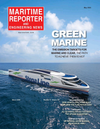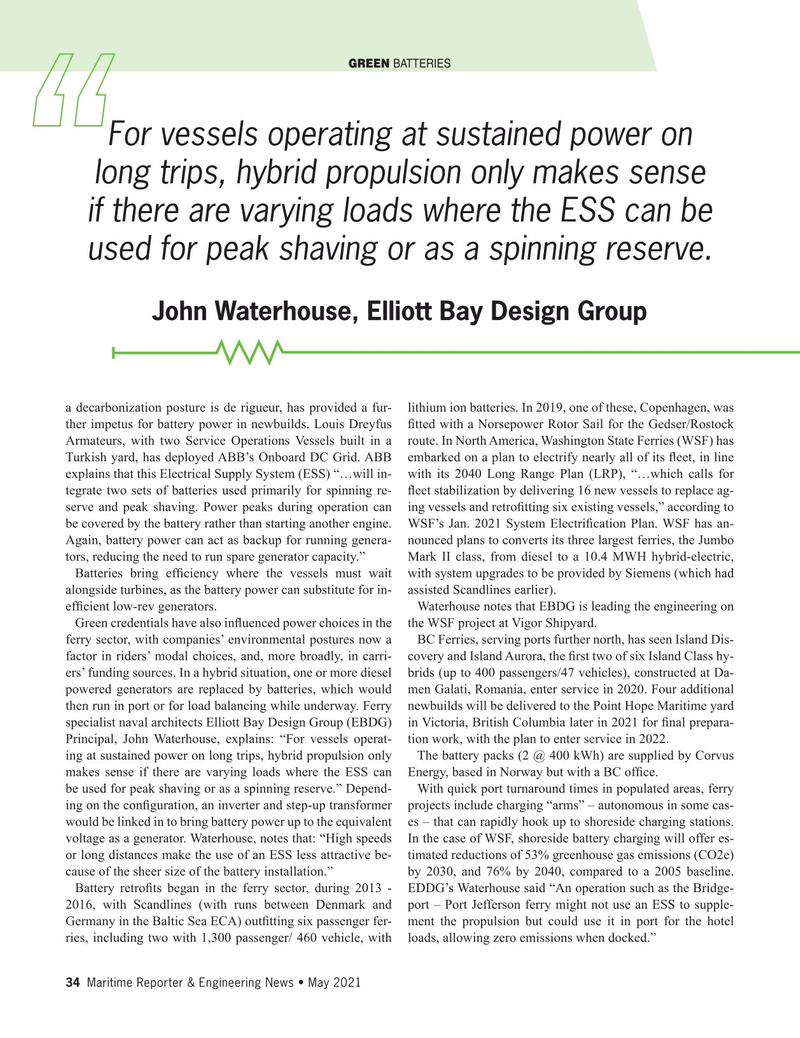
Page 34: of Maritime Reporter Magazine (May 2021)
Green Ship Technologies
Read this page in Pdf, Flash or Html5 edition of May 2021 Maritime Reporter Magazine
GREEN BATTERIES
For vessels operating at sustained power on long trips, hybrid propulsion only makes sense if there are varying loads where the ESS can be used for peak shaving or as a spinning reserve.
John Waterhouse, Elliott Bay Design Group a decarbonization posture is de rigueur, has provided a fur- lithium ion batteries. In 2019, one of these, Copenhagen, was ther impetus for battery power in newbuilds. Louis Dreyfus ? tted with a Norsepower Rotor Sail for the Gedser/Rostock
Armateurs, with two Service Operations Vessels built in a route. In North America, Washington State Ferries (WSF) has
Turkish yard, has deployed ABB’s Onboard DC Grid. ABB embarked on a plan to electrify nearly all of its ? eet, in line explains that this Electrical Supply System (ESS) “…will in- with its 2040 Long Range Plan (LRP), “…which calls for tegrate two sets of batteries used primarily for spinning re- ? eet stabilization by delivering 16 new vessels to replace ag- serve and peak shaving. Power peaks during operation can ing vessels and retro? tting six existing vessels,” according to be covered by the battery rather than starting another engine. WSF’s Jan. 2021 System Electri? cation Plan. WSF has an-
Again, battery power can act as backup for running genera- nounced plans to converts its three largest ferries, the Jumbo tors, reducing the need to run spare generator capacity.” Mark II class, from diesel to a 10.4 MWH hybrid-electric,
Batteries bring ef? ciency where the vessels must wait with system upgrades to be provided by Siemens (which had alongside turbines, as the battery power can substitute for in- assisted Scandlines earlier). ef? cient low-rev generators. Waterhouse notes that EBDG is leading the engineering on
Green credentials have also in? uenced power choices in the the WSF project at Vigor Shipyard.
ferry sector, with companies’ environmental postures now a BC Ferries, serving ports further north, has seen Island Dis- factor in riders’ modal choices, and, more broadly, in carri- covery and Island Aurora, the ? rst two of six Island Class hy- ers’ funding sources. In a hybrid situation, one or more diesel brids (up to 400 passengers/47 vehicles), constructed at Da- powered generators are replaced by batteries, which would men Galati, Romania, enter service in 2020. Four additional then run in port or for load balancing while underway. Ferry newbuilds will be delivered to the Point Hope Maritime yard specialist naval architects Elliott Bay Design Group (EBDG) in Victoria, British Columbia later in 2021 for ? nal prepara-
Principal, John Waterhouse, explains: “For vessels operat- tion work, with the plan to enter service in 2022. ing at sustained power on long trips, hybrid propulsion only The battery packs (2 @ 400 kWh) are supplied by Corvus makes sense if there are varying loads where the ESS can Energy, based in Norway but with a BC of? ce. be used for peak shaving or as a spinning reserve.” Depend- With quick port turnaround times in populated areas, ferry ing on the con? guration, an inverter and step-up transformer projects include charging “arms” – autonomous in some cas- would be linked in to bring battery power up to the equivalent es – that can rapidly hook up to shoreside charging stations. voltage as a generator. Waterhouse, notes that: “High speeds In the case of WSF, shoreside battery charging will offer es- or long distances make the use of an ESS less attractive be- timated reductions of 53% greenhouse gas emissions (CO2e) cause of the sheer size of the battery installation.” by 2030, and 76% by 2040, compared to a 2005 baseline.
Battery retro? ts began in the ferry sector, during 2013 - EDDG’s Waterhouse said “An operation such as the Bridge- 2016, with Scandlines (with runs between Denmark and port – Port Jefferson ferry might not use an ESS to supple-
Germany in the Baltic Sea ECA) out? tting six passenger fer- ment the propulsion but could use it in port for the hotel ries, including two with 1,300 passenger/ 460 vehicle, with loads, allowing zero emissions when docked.” 34 Maritime Reporter & Engineering News • May 2021
MR #5 (34-49).indd 34 5/6/2021 4:56:37 PM

 33
33

 35
35
